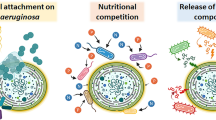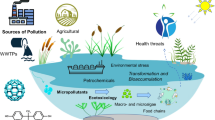Abstract
Changes in the bioaccumulation of 2,2′,4,4′-tetrabromodiphenyl ether (BDE-47) in the marine alga Heterosigma akashiwo (Raphidophyceae) were examined for different concentrations of nitrate (0, 128, and 512 μmol dm−3) and phosphate (0, 8, and 32 μmol dm−3) in the semi-continuous culture with 20% renewal rate. The BDE-47 content per cell and per culture, as well as the accumulated percentage of available BDE-47, presented a significant decreasing trend with the increase in nitrate and phosphate concentrations. The N-0 (4.0 × 10−6 ng cell−1) and P-0 (5.8 × 10−6 ng cell−1) treatments had significantly higher BDE-47 content per cell than other treatments. In comparison, the difference in BDE-47 per algal culture and accumulated percentage between the nitrate treatments or phosphate treatments was not as obvious as the BDE-47 content per cell. BDE-47 per cell presented significantly negative correlation with nitrate and phosphate concentrations, and the accumulated BDE-47 was in positive correlation with lipid content. log BAFlip for BDE-47 in H. akashiwo ranged from 6.70 to 7.25. The results of this study indicate that variation in BDE-47 accumulation by H. akashiwo corresponds to the change in cellular lipid content induced by different nitrate and phosphate concentrations.
Similar content being viewed by others
References
Berdalet, E., Latasa, M. & Estrada, M. (1994). Effects of nitrogen and phosphorus starvation on nucleic acid and protein content of Heterocapsa sp. Journal of Plankton Research, 16(4), 303–316.
Berglund, O., Larsson, P., Ewald, G. & Okla, L. (2000). Bioaccumulation and differential partitioning of polychlorinated biphenyls in freshwater, planktonic food webs. Canadian Journal of Fisheries and Aquatic Sciences, 57, 1160–1168.
Bligh, E.G. & Dyer, W.J. (1959). A rapid method of total lipid extraction and purification. Canadian Journal of Biochemistry and Physiology, 37, 911–917.
Borghesi, N., Corsolini, S., & Focardi, S. (2008). Levels of polybrominated diphenyl ethers (PBDEs) and organochlorine pollutants in two species of Antarctic fish (Chionodraco hamatus and Trematomus bernacchii). Chemosphere, 73(2), 155–160.
Bradford, M. (1976). A rapid and sensitive method for the quantitation of microgram quantities of protein utilizing the principle of protein dye-binding. Analytical Biochemistry, 72, 248–254.
Carlson, D.L. & Swackhamer, D.L. (2006). Results from the US Great Lakes fish monitoring program and effects of lake processes on bioaccumulative contaminant concentrations. Journal of Great Lakes Research, 32, 370–385.
Chiuchiolo, A.L., Dickhut, R.M., Cochran, M.A. & Ducklow, H.W. (2004). Persistent organic pollutants at the base of the Antarctic marine food Web. Environmental Science and Technology, 38(13), 3551–3557.
Cunningham, S.D. & Berti, W.R. (1993). Remediation of contaminated soils with green plants: an overview. In Vitro Cellular & Developmental Biology, 29(4), 207–212.
Datta, S. (2001). Relationship between PCB uptake and nutrient limitation in three algal species. Unpublished doctoral dissertation, Drexel University, Philadelphia, PA, USA.
De Wit, C.A. (2002). An overview of brominated flame retardants in the environment. Chemosphere, 46(5), 583–624.
De Wit, C.A., Alaee, M. & Muir, D.C.G. (2006) Levels and trends of brominated flame retardants in the Arctic. Chemosphere, 64(2), 209–233.
Fang K. (2006). Studies on the adsorption of PCBs to marine microalgae. Unpublished Master Thesis, Dalian Maritime University, Dalian, China (in Chinese with English abstract).
Fogg, G.E. (1959). Nitrogen nutrition and metabolic patterns in algae. Symposia of the Society for Experimental Biology, 13, 106–125.
Fontana, A.R., Silva, M.F., Martinez, L.D., Wuilloud R.G. & Altamirano, J.C. (2009). Determination of polybrominated diphenyl ethers in water and soil samples by cloud point extraction-ultrasound-assisted back-extraction-gas chromatography-mass spectrometry. Journal of Chromatography A, 1216,4339–4346.
Gerofke, A., Komp, P. & McLachlan, M.S. (2005). Bioconcentration of persistent organic pollutants in four species of marine phytoplankton. Environmental Toxicology and Chemistry, 24, 2908–2917.
Grasshoff, K. (1976). Methods of Seawater Analysis. Verlag Chemie, Weinheim New York.
Guan, Y.F., Samuel Sojinu, O.S., Li S.M. & Zeng, E.Y. (2009). Fate of polybrominated diphenyl ethers in the environment of the Pearl River Estuary, South China. Environmental Pollution, 157, 2166–2172.
Guan, Y.F., Tu, X.Y. & Wu H.H. (2011). Distribution and source of polybrominated diphenyl ethers (PBDEs). Ecology and Environmental Sciences, 20(3), 474–479(in Chinese with English abstract).
Guo, J.Y., Wu, F.C., Mai, B.X., Luo, X.J. & Zeng, E.Y. (2007). Polybrominated diphenyl ethers in seafood products of South China. Journal of Agricultural and Food Chemistry, 55, 9152–9158.
Hale, R.C., Alaeeb, M.J., Manchester-Neesvigc, B., Stapletond, H.M. & Ikonomou, M.G. (2003). Polybrominated diphenyl ether flame retardants in the North American environment. Environment International, 29(6), 771–779.
Halling-Sørensen, B., Nyholm, N., Kusk, K.O. & Jacobsson, E. (2000). Influence of nitrogen status on the bioconcentration of hydrophobic organic compounds to Selenastrum capricornutum. Ecotoxicology and Environmental Safety, 45, 33–42.
Hites, R.A. (2004). Polybrominated diphenylethers in the environment and in people: a meta-analysis of concerntrations. Environmental Science and Technology, 38, 945–956.
Huang, X.P., Huang, L.M. & Yue. W.Z. (2003). The characteristics of nutrients and eutrophication in the Pearl River estuary, South China. Marine Pollution Bulletin, 47(1–6), 30–36.
Ji, D.W., Yang J.Q., Gao Z.H. & Jia Y.G. (2007). Eutrophication assessment of the western sea area in the Laizhou Bay during the low water period. Journal of Marine Science Bulletin, 26(1), 78–81(in Chinese with English abstract).
Jin, J., Liu, W.Z., Wang, Y. & Tang. X.Y. (2008). Levels and distribution of polybrominated diphenyl ethers in plant, shellfish and sediment samples from Laizhou Bay in China. Chemosphere, 71(6), 1043–1050.
Justic, D., Rabalais, N.N., Turner, R.E. & Dortch, Q. (1995). Changes in nutrient structure of river-dominated coastal waters: stoichiometric nutrient balance and its consequences. Estuarine Coastal and Shelf Science, 40, 339–356.
Khan, S., Arakawa, O. & Onoue, Y. (1997). Neurotoxins in a toxic red tide of Heterosigma akashiwo (Raphidophyceae) in Kagoshima Bay, Japan. Aquaculture Research, 28(1), 9–14.
Khozin-Goldberg, I. & Cohen, Z. (2006). The effect of phosphate starvation on the lipid and fatty acid composition of the fresh water eustigmatophyte Monodus subterraneus. Phytochemistry, 67, 696–701.
Kilham, S.S. (1998). Effects of physiological state on the bioaccumulation of toxic chemicals in algae and their transfer to zooplankton. Verhandlungen-Internationale Vereinigung für theoretische und angewandte Limnologie, 26, 1734–1736.
Kilham, S.S., Kreeger, D.A., Goulden, C.E. & Lynn, S.G. (1997). Effects of nutrient limitation on biochemical constituents of Ankystrodesmus falcatus. Freshwater Biology, 38, 591–596.
Kochert, G. (1978). Carbohydrate determination by phenol-sulfuric acid method. In: J.A. Hellebust & J.S. Craige (Eds.), Handbook of physiological and biochemical method s (pp.95–97). Cambridge University Press, London.
Lai, J.X., Yu, Z.M., Song, X.X., Cao, X.H. & Han. X.T. (2011). Responses of the growth and biochemical composition of Prorocentrum donghaiense to different nitrogen and phosphorus concentrations. Journal of Experimental Marine Biology and Ecology, 405, 6–17.
Landry, M.R. & Hassett, R.P. (1982). Estimating the grazing impact of marine microzooplankton. Marine Biology, 67, 283–288.
Law, R.J., Allchin, C.R., de Boer, J., Covaci, A., Herzke, D., Lepom, P., Morris, S., Tronczynski J. & De Wit, C.A. (2006). Levels and trends of brominated flame retardants in the European environment. Chemosphere, 64(2), 187–208.
Li, M., Gong, R., Rao, X., Liu, Z.H. & Wang, X. (2005). Effects of nitrate concentration on growth and fatty acid composition of the marine microalgae Pavlova viridis (Prymnesiophyceae). Annals of Microbiology, 55, 51–55.
Liu, S.M., Zhang, J., Chen, H.T. & Zhang, G.S. (2005). Factors influencing nutrient dynamics in the eutrophic Jiaozhou Bay, North China. Progress in Oceanography, 66(1), 66–85.
Lourenço, S.O., Marquez, U.M.L., Mancinifilho, J., Barbarino, E. & Aidar, E. (1997). Changes in biochemical profile of Tetraselmis gracilis I. Comparison of two culture media. Aquaculture, 148, 153–168.
Luo, X.J., Yu, M., Mai, B.X. & Chen, S.J. (2008). Distribution and partition of polybrominated diphenyl ethers (PBDEs) in water of the Zhujiang River Estuary. Chinese Science Bulletin, 53(4), 493–500.
Lynn, S.G., Price, D.J., Birge, W.J. & Kilham, S.S. (2007). Effect of nutrient availability on the uptake of PCB congener 2,2′,6,6′-tetrachlorobiphenyl by a diatom (Stephanodiscus minutulus) and transfer to a zooplankton (Daphnia pulicaria). Aquatic Toxicology, 83, 24–32.
Meng, X.Z., Yu, L.P., Guo, Y., Mai, B.X. & Zeng, E.Y. (2008). Congener-specific distribution of polybrominated diohenyl ethers in fish of China: implication for input sources. Environmental Toxicology and Chemistry, 27, 67–72.
Merzlyak, M.N., Chivkunova, O.B., Gorelova, O.A., Reshetnikova, I.V., Solovchenko, A.E., Khozin-Goldberg, I. & Cohen, Z. (2007). Effect of nitrogen starvation on optical properties, pigments, and arachidonic acid content of the unicellular green alga Parietochloris incise (Trebouxiophyceae, Chlorophyta). Journal of Applied Phycology, 43, 833–843.
Ohta, S., Ishizuka, D., Nishimura, H., Nakao, T., Aozasa, O., Shimidzu, Y., Ochiai, F., Kida, T., Nishi, M. & Miyata, H. (2002). Comparison of polybrominated diphenyl ethers in fish, vegetables, and meats and levels in human milk of nursing women in Japan. Chemosphere, 46(5), 689–696.
Oros, D.R., Hoover, D., Rodigari, F., Crane, D. & Sericano, J. (2005). Levels and distribution of polybrominated diphenyl ethers in water, surface sediments, and bivalves from the San Francisco Estuary. Environmental Science and Technology, 39(1), 33–41.
Pande, S.V., Parvin, R. & Venkitasubramanian, T.A. (1963). Microdetermination of lipids and serum total fatty acids. Analytical Biochemistry, 6, 415–425.
Rahman, F., Langford, K.H., Scrimshaw, M.D. & Lester, J. N. (2001). Polybrominated diphenyl ether (PBDE) flame retardants. Science of the Total Environment, 275(1–3), 1–17.
Rausch, T. (1981). The estimation of micro-algal protein content and its meaning to the evaluation of algal biomass I. Comparison of methods for extracting protein. Hydrobiologia, 78, 237–251.
Sellström, U., Jansson, B., Kierkegaard, A., de Wit, C., Odsjö, T. & Olsson, M. (1993). Polybrominated diphenyl ethers (PBDE) in biological samples from the Swedish environment. Chemosphere, 26(9), 1703–1718.
Smith, V.H. (2003). Eutrophication of freshwater and coastal marine ecosystems: a global problem. Environmental Science and Pollution Research, 10(2), 126–139.
Stange, K. & Swackhamer, D.L. (1994). Factors affecting phytoplankton species-specific differences in accumulation of 40 polychlorinated biphenyls (PCBs). Environmental Toxicology and Chemistry, 13, 1849–1860.
Strickland, J.D.H. & Parsons, T.R. (1972). A practical handbook of seawater analysis. Fisheries Research Board of Canada, 167, 311.
Suzuki, G., Nose, K., Takigami, H., Takahashi, S. Sakai, S.I. (2006). PBDEs and PBDD/Fs in house and office dust from Japan. Organohalogen Compounds, 68, 1843–1846.
Swackhamer, D.L. (1985). The Role of water particle partitioning and sedimentation in controlling the fate and transport of PCBs in lakes. Unpublished doctoral dissertation, University of Wisconsin, Madison, WI, USA.
Swackhamer, D.L. & Skoglund, R.S. (1993). Bioaccumulation of PCBs by algae: kinetics versus equilibrium. Environmental Toxicology and Chemistry, 12, 831–838.
Thompson, G.A. Jr. (1996). Lipids and membrane function in green algae. Biochimica et Biophysica Acta, 1302, 17–45.
Wang, Y.W., Jiang, G.B., Lam P.K.S. & Li, A. (2007). Polybrominated diphenyl ether in the East Asian environment: A critical review. Environment International, 33(7), 963–973.
Yang Y.L., Pan, J., Li, Y., Yin, X.C. & Hi, L. (2004). Persistent organic pollutants PCNs and PBDEs in sediments from coastal waters of Qingdao, Shandong Peninsula. Chinese Science Bulletin, 49(1), 98–106.
Zhao, Y.F., Yu, Z.M., Song, X.X. & Cao, X.H. (2009). Biochemical compositions of two dominant bloom-forming species isolated from the Yangtze River Estuary in response to different nutrient conditions. Journal of Experimental Marine Biology and Ecology, 368(1), 30–36.
Author information
Authors and Affiliations
Corresponding author
About this article
Cite this article
Ge, W., Yin, X., Chai, C. et al. Bioaccumulation of PBDE congener 2,2′,4,4′-tetrabromodiphenyl ether by Heterosigma akashiwo in response to different nutrient concentrations. Ocean and Hydro 42, 139–148 (2013). https://doi.org/10.2478/s13545-013-0067-x
Received:
Accepted:
Published:
Issue Date:
DOI: https://doi.org/10.2478/s13545-013-0067-x




